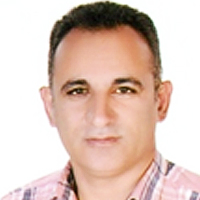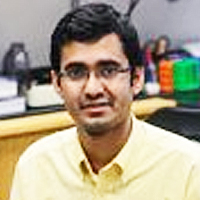Abstract
Case Report
Congenital Dysfibrinogenaemia: A Family Case Report
G García-Donas*, MT Vargas, C Martínez-Chinchilla, N Alkadi and A Rodríguez
Published: 03 December, 2024 | Volume 8 - Issue 1 | Pages: 034-038
Congenital fibrinogen qualitative disorders, including dysfibrinogenemia and hypo-dysfibrinogenaemia, are highly heterogeneous, both in clinical manifestation and for the mutational molecular spectrum driving these disorders. Correlations between phenotype and genotype remain poorly defined. Considerable work lies ahead in order to achieve diagnostic and prognostic precision and subsequently provide targeted management for this rare disease. Here we report the laboratory test, the clinical and molecular characterisation of a family with dysfibrinogenemia.
Read Full Article HTML DOI: 10.29328/journal.jhcr.1001032 Cite this Article Read Full Article PDF
Keywords:
Congenital fibrinogen disorders; Dysfibrinogenaemia; Genotype-phenotype correlation; Next-generation sequencing
References
- Palla R, Peyvandi F, Shapiro AD. Rare bleeding disorders: diagnosis and treatment. Blood. 2015 26;125(13):2052-61. Available from: https://doi.org/10.1182/blood-2014-08-532820
- Mumford AD, Ackroyd S, Alikhan R, Bowles L, Chowdary P, Grainger J, et al. BCSH Committee. Guideline for the diagnosis and management of the rare coagulation disorders: a United Kingdom Haemophilia Centre Doctors' Organization guideline on behalf of the British Committee for Standards in Haematology. Br J Haematol. 2014 ;167(3):304-26. Available from: https://doi.org/10.1111/bjh.13058
- Casini A, Undas A, Palla R, Thachil J, de Moerloose P. Diagnosis and classification of congenital fibrinogen disorders: communication from the SSC of the ISTH. J Thromb Haemost. 2018;16(9):1887–90. Available from: https://doi.org/10.1111/jth.14216
- Cunningham MT, Brandt JT, Laposata M, Olson JD. Laboratory diagnosis of dysfibrinogenemia. Arch Pathol Lab Med. 2002;126(4):499-505. Available from: https://doi.org/10.5858/2002-126-0499-ldod
- Miesbach W, Schenk J, Alesci S, Lindhoff-Last E. Comparison of the fibrinogen Clauss assay and the fibrinogen PT-derived method in patients with dysfibrinogenemia. Thromb Res. 2010;126(6):e428–33. Available from: https://doi.org/10.1016/j.thromres.2010.09.004
- Galanakis DK. Afibrinogenemias and dysfibrinogenemias. In: Marder V, White GC, Aird WC, editors. Hemostasis and Thrombosis: Basic Principles and Clinical Practice. Philadelphia: Lippincott Williams & Wilkins. 2012;693-708.
- Cunningham F, Allen JE, Allen J, Alvarez-Jarreta J, Amode MR, Armean IM, et al. Ensembl 2022. Nucleic Acids Res. 2022;50(D1):D988–95. Available from: https://doi.org/10.1093/nar/gkab1049
- Shapiro SE, Phillips E, Manning RA, Morse CV, Murden SL, Laffan MA, Mumford AD. Clinical phenotype, laboratory features, and genotype of 35 patients with heritable dysfibrinogenaemia. Br J Haematol. 2013;160(2):220-7. Available from: https://doi.org/10.1111/bjh.12085
- Ebert RF. Index of Variant Human Fibrinogens. Boca Raton, Ann Arbor, Boston: CRC Press; 1994. Available from: https://www.routledge.com/Index-of-Variant-Human-Fibrinogens/Ebert/p/book/9780849389986?srsltid=AfmBOopqoE9HdkcaIiZ7BrhTrATa5hagIOZ2AJ3ShfalPEizfz5JcfOY
- Smith N, Bornikova L, Noetzli L, Guglielmone H, Minoldo S, Backos DS, et al. Identification and characterization of novel mutations implicated in congenital fibrinogen disorders. Res Pract Thromb Haemost. 2018;2(4):800-811. Available from: https://doi.org/10.1002/rth2.12127
- Casini A, Neerman-Arbez M, Ariëns RA, de Moerloose P. Dysfibrinogenemia: from molecular anomalies to clinical manifestations and management. J Thromb Haemost. 2015;13(6):909-19. Available from: https://doi.org/10.1111/jth.12916
- Neerman-Arbez M, de Moerloose P, Bridel C, Honsberger A, Schönbörner A, Rossier C, et al. Mutations in the fibrinogen α gene account for the majority of cases of congenital afibrinogenemia. Blood. 2000;96(1):149-52. PMID: 10891444. Available from: https://pubmed.ncbi.nlm.nih.gov/10891444/
- Hanss M, Biot F. A database for human fibrinogen variants. Ann NY Acad Sci. 2001;936:89–90. Available from: https://doi.org/10.1111/j.1749-6632.2001.tb03495.x
- Casini A, Blondon M, Lebreton A, Koegel J, Tintillier V, de Maistre E, et al. Natural history of patients with congenital dysfibrinogenemia. Blood. 2015;125(3):553–61. Available from: https://doi.org/10.1182/blood-2014-06-582866
- Haverkate F, Samama M. Familial dysfibrinogenemia and thrombophilia. Report on a study of the SSC Subcommittee on Fibrinogen. Thromb Haemost. 1995;73(1):151-61. PMID: 7740487. Available from: https://pubmed.ncbi.nlm.nih.gov/7740487/
- Asselta R, Platè M, Robusto M, Borhany M, Guella I, Soldà G, et al. Clinical and molecular characterisation of 21 patients affected by quantitative fibrinogen deficiency. Thromb Haemost. 2015;113(3):567-76. Available from: https://doi.org/10.1160/th14-07-0629
- Bor MV, Feddersen S, Pedersen IS, Sidelmann JJ, Kristensen SR. Dysfibrinogenemia-Potential Impact of Genotype on Thrombosis or Bleeding. Semin Thromb Hemost. 2022;48(2):161-173. Available from: https://doi.org/10.1055/s-0041-1730358
- Ramanan R, McFadyen JD, Perkins AC, Tran HA. Congenital fibrinogen disorders: Strengthening genotype-phenotype correlations through novel genetic diagnostic tools. Br J Haematol. 2023;203(3):355-368. Available from: https://doi.org/10.1111/bjh.19039
- Peyvandi F, Kaufman RJ, Seligsohn U, Salomon O, Bolton-Maggs PH, et al. Rare bleeding disorders. Haemophilia. 2006;12 Suppl 3:137-42. Available from: https://doi.org/10.1111/j.1365-2516.2006.01271.x
- Duric N, Szakmany T. The role of rotational thromboelastometry in understanding the coagulation problems in COVID-19 associated critical illness. Anaesthesiol Intensive Ther. 2021;53(4):336-342. Available from: https://doi.org/10.5114/ait.2021.109401
- Reardon B, Pasalic L, Favaloro EJ. The Role of Viscoelastic Testing in Assessing Hemostasis: A Challenge to Standard Laboratory Assays? J Clin Med. 2024;13(12):3612. Available from: https://doi.org/10.3390/jcm13123612
- Williams M, Green K. Role of mass spectrometry in the diagnosis of congenital fibrinogen defects. Blood Coagulation & Fibrinolysis. 2021;32(4):333-338.
- Tian D, Liang J, Gao H, Xu X, Nie W, Yin M, et al. Clinical phenotype and laboratory characteristics of 93 patients with congenital fibrinogen disorders from unrelated 36 families. Res Pract Thromb Haemost. 2024;8:e102445. Available from: https://doi.org/10.1016/j.rpth.2024.102445
- Castaman G, Kessler CM. Genotype-phenotype correlation in congenital dysfibrinogenemia: New insights. Blood Adv. 2022;6(16):4978-4984.
- Paraboschi EM, Duga S, Asselta R. Fibrinogen as a pleiotropic protein causing human diseases: The mutational burden of Aα, Bβ, and γ chains. Int J Mol Sci. 2017;18(12):2711. Available from: https://doi.org/10.3390/ijms18122711
- Zhou J, Ding Q, Chen Y, Ouyang Q, Jiang L, Dai J, et al. Clinical features and molecular basis of 102 Chinese patients with congenital fibrinogen disorders. Blood Cells Mol Dis. 2015;55(4):308–15. Available from: https://doi.org/10.1016/j.bcmd.2015.06.002
- Marchi R, Vilar R, Durual S, Goodyer M, Gay V, Neerman-Arbez M, et al. Fibrin clot properties to assess the bleeding phenotype in unrelated patients with hypodysfibrinogenemia due to novel fibrinogen mutations. Thromb Res. 2021;197:56–64. Available from: https://doi.org/10.1016/j.thromres.2020.11.003
- Ceznerova E, Kaufmanova J, Sovova Ž, Štikarova J, Loužil J, Kotlin R, et al. Structural and functional characterization of four novel fibrinogen mutations in FGB causing congenital fibrinogen disorder. Int J Mol Sci. 2022;23(2):721. Available from: https://doi.org/10.3390/ijms23020721
- Moret A, Zuniga A, Ibanez M, Cid AR, Haya S, Ferrando F, et al. Clinical and molecular characterization by next generation sequencing of Spanish patients affected by congenital deficiencies of fibrinogen. Thromb Res. 2019;180:115–7. Available from: https://doi.org/10.1016/j.thromres.2019.06.015
- Liu X, Wang X, Zhang J. Advances in the genetic diagnosis of congenital dysfibrinogenemia: the role of next-generation sequencing. J Thromb Haemost. 2023;21(7):1355-1363.
- Gindele R, Kerenyi A, Kallai J, Pfliegler G, Schlammadinger A, Szegedi I, et al. Resolving differential diagnostic problems in von Willebrand disease, in fibrinogen disorders, in Prekallikrein deficiency and in hereditary hemorrhagic telangiectasia by next-generation sequencing. Life. 2021;11(3):202. Available from: https://doi.org/10.3390/life11030202
- Neerman-Arbez M, de Moerloose P. Williams Hematology. New York: McGraw-Hill; 2010.
- Weisel JW, Litvinov RI. Mechanisms of fibrin polymerization and clinical implications. Blood. 2013;121(10):1712-9. Available from: https://doi.org/10.1182/blood-2012-09-306639
- Richard M, Celeny D, Neerman-Arbez M. Mutations accounting for congenital fibrinogen disorders: an update. Semin Thromb Hemost. 2022;48(8):889–903. Available from: https://doi.org/10.1055/s-0041-1742170
- Meh DA, Mosesson MW, Siebenlist KR, Simpson-Haidaris PJ, Brennan SO, DiOrio JP, et al. Fibrinogen Naples I (B beta A68T) nonsubstrate thrombin-binding capacities. Thromb Res. 2001;103(1):63–73. Available from: https://epublications.marquette.edu/biomedsci_fac/47/
- Huffman JE, de Vries PS, Morrison AC, Sabater-Lleal M, Kacprowski T, Auer PL, et al. Rare and low-frequency variants and their association with plasma levels of fibrinogen, FVII, FVIII, and vWF. Blood. 2015;126(11):e19–e29. Available from: https://doi.org/10.1182/blood-2015-02-624551
- de Vries PS, Chasman DI, Sabater-Lleal M, Chen MH, Huffman JE, Steri M, et al. A meta-analysis of 120,246 individuals identifies 18 new loci for fibrinogen concentration. Hum Mol Genet. 2016;25(2):358–70. Available from: https://doi.org/10.1093/hmg/ddv454
- Pankratz N, Wei P, Brody JA, Chen MH, de Vries PS, Huffman JE, et al. Whole-exome sequencing of 14,389 individuals from the ESP and CHARGE consortia identifies novel rare variation associated with hemostatic factors. Hum Mol Genet. 2022;31(18):3120–32. Available from: https://doi.org/10.1093/hmg/ddac100
- Bornikova L, Peyvandi F, Allen G, Bernstein J, Manco-Johnson MJ. Fibrinogen replacement therapy for congenital fibrinogen deficiency. J Thromb Haemost. 2011;9(9):1687-704. Available from: https://doi.org/10.1111/j.1538-7836.2011.04424.x
- Casini A, de Moerloose P. How I treat dysfibrinogenemia. Blood. 2021;138(21):2021–2030. Available from: https://doi.org/10.1182/blood.2020010116
- Li Y, Ding B, Wang X, Ding Q. Congenital (hypo-)dysfibrinogenemia and bleeding: A systematic literature review. Thromb Res. 2022;217:36-47. Available from: https://doi.org/10.1016/j.thromres.2022.07.005
- Casini A, de Moerloose P. Can the phenotype of inherited fibrinogen disorders be predicted? Haemophilia. 2016;22(5):667-75. Available from: https://doi.org/10.1111/hae.12967
- Casini A. From Routine to Research Laboratory: Strategies for the Diagnosis of Congenital Fibrinogen Disorders. Hamostaseologie. 2020;40(4):460-466. Available from: https://doi.org/10.1055/a-1182-3510
Figures:

Figure 1
Similar Articles
-
Myeloid Neoplasms: Better Understanding of their Molecular Pathogenesis with Improvised Genomic Testing: A Ray of Hope for Better Clinical OutcomesBhardwaj Tina Neelesh*, Phani MN. Myeloid Neoplasms: Better Understanding of their Molecular Pathogenesis with Improvised Genomic Testing: A Ray of Hope for Better Clinical Outcomes. . 2024 doi: 10.29328/journal.jhcr.1001027; 8: 001-007
-
Congenital Dysfibrinogenaemia: A Family Case ReportG García-Donas*,MT Vargas,C Martínez-Chinchilla,N Alkadi,A Rodríguez. Congenital Dysfibrinogenaemia: A Family Case Report. . 2024 doi: 10.29328/journal.jhcr.1001032; 8: 034-038
Recently Viewed
-
Do Fishes Hallucinate Human Folks?Dinesh R*,Sherry Abraham,Kathiresan K,Susitharan V,Jeyapavithran C,Paul Nathaniel T,Siva Ganesh P. Do Fishes Hallucinate Human Folks?. Arch Food Nutr Sci. 2017: doi: 10.29328/journal.afns.1001003; 1: 020-023
-
Assessment of Redox Patterns at the Transcriptional and Systemic Levels in Newly Diagnosed Acute LeukemiaAna Carolina Agüero Aguilera, María Eugenia Mónaco, Sandra Lazarte, Emilse Ledesma Achem, Natalia Sofía Álvarez Asensio, Magdalena María Terán, Blanca Alicia Issé, Marcela Medina, Cecilia Haro*. Assessment of Redox Patterns at the Transcriptional and Systemic Levels in Newly Diagnosed Acute Leukemia. J Hematol Clin Res. 2024: doi: 10.29328/journal.jhcr.1001029; 8: 017-023
-
Assessment of Indigenous Knowledge on Using of Traditional Medicinal Plants to Cure Human Diseases in South Omo Zone Baka Dawla Ari District, Kure and Bitsmal South EthiopiaGizaw Bejigo*. Assessment of Indigenous Knowledge on Using of Traditional Medicinal Plants to Cure Human Diseases in South Omo Zone Baka Dawla Ari District, Kure and Bitsmal South Ethiopia. J Plant Sci Phytopathol. 2024: doi: 10.29328/journal.jpsp.1001132; 8: 048-054
-
Nanoencapsulated Extracts from Leaves of Bauhinia forficata Link: In vitro Antioxidant, Toxicogenetic, and Hypoglycemic Activity Effects in Streptozotocin-induced Diabetic MiceBárbara Verônica Cardoso de Souza, Alessandra Braga Ribeiro*, Rita de Cássia Meneses Oliveira, Julianne Viana Freire Portela, Ana Amélia de Carvalho Melo Cavalcante, Esmeralda Maria Lustosa Barros, Luís Felipe Lima Matos, Tarsia Giabardo Alves, Maria. Nanoencapsulated Extracts from Leaves of Bauhinia forficata Link: In vitro Antioxidant, Toxicogenetic, and Hypoglycemic Activity Effects in Streptozotocin-induced Diabetic Mice. Arch Pharm Pharma Sci. 2024: doi: 10.29328/journal.apps.1001063; 8: 100-115
-
GELS as Pharmaceutical Form in Hospital Galenic Practice: Chemico-physical and Pharmaceutical AspectsLuisetto M*,Edbey Kaled,Mashori GR,Ferraiuolo A,Fiazza C,Cabianca L,Latyschev OY. GELS as Pharmaceutical Form in Hospital Galenic Practice: Chemico-physical and Pharmaceutical Aspects. Arch Surg Clin Res. 2025: doi: 10.29328/journal.ascr.1001084; 9: 001-007
Most Viewed
-
Evaluation of Biostimulants Based on Recovered Protein Hydrolysates from Animal By-products as Plant Growth EnhancersH Pérez-Aguilar*, M Lacruz-Asaro, F Arán-Ais. Evaluation of Biostimulants Based on Recovered Protein Hydrolysates from Animal By-products as Plant Growth Enhancers. J Plant Sci Phytopathol. 2023 doi: 10.29328/journal.jpsp.1001104; 7: 042-047
-
Sinonasal Myxoma Extending into the Orbit in a 4-Year Old: A Case PresentationJulian A Purrinos*, Ramzi Younis. Sinonasal Myxoma Extending into the Orbit in a 4-Year Old: A Case Presentation. Arch Case Rep. 2024 doi: 10.29328/journal.acr.1001099; 8: 075-077
-
Feasibility study of magnetic sensing for detecting single-neuron action potentialsDenis Tonini,Kai Wu,Renata Saha,Jian-Ping Wang*. Feasibility study of magnetic sensing for detecting single-neuron action potentials. Ann Biomed Sci Eng. 2022 doi: 10.29328/journal.abse.1001018; 6: 019-029
-
Pediatric Dysgerminoma: Unveiling a Rare Ovarian TumorFaten Limaiem*, Khalil Saffar, Ahmed Halouani. Pediatric Dysgerminoma: Unveiling a Rare Ovarian Tumor. Arch Case Rep. 2024 doi: 10.29328/journal.acr.1001087; 8: 010-013
-
Physical activity can change the physiological and psychological circumstances during COVID-19 pandemic: A narrative reviewKhashayar Maroufi*. Physical activity can change the physiological and psychological circumstances during COVID-19 pandemic: A narrative review. J Sports Med Ther. 2021 doi: 10.29328/journal.jsmt.1001051; 6: 001-007

HSPI: We're glad you're here. Please click "create a new Query" if you are a new visitor to our website and need further information from us.
If you are already a member of our network and need to keep track of any developments regarding a question you have already submitted, click "take me to my Query."



















































































































































